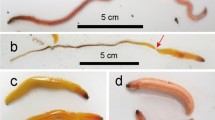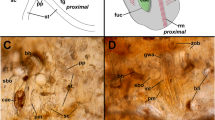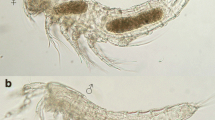Abstract
Our investigations on different developmental stages of the jellyfish Cassiopea andromeda (Forskål, 1775) provide updated descriptions of nematocyst types and asexual reproduction modes, which were documented by drawings and high-resolution photographs. In contrast to previous studies that only described three types of nematocysts, we revealed five types: a-isorhizas, O-isorhizas, euryteles, large oval birhopaloids, and small lemon-shaped birhopaloids. Comparisons of undischarged and discharged capsules revealed significantly smaller capsule volumes (48–51 %) in the latter. We provide capsule lengths and widths ranges for each capsule type (undischarged) and developmental stage. We demonstrate that for most capsule types the calculated capsule volumes were positively correlated with the progressing development and increasing size of the five developmental stages, namely bud, polyp, strobila, ephyra, and medusa. O-isorhizas were only present in the latter three stages probably due to a change in diet related to a changing life style. Besides asexual reproduction by swimming buds and monodisc strobilation common in rhizostome Kolpophorae, we documented lateral polyp budding for the first time in this taxon. Our results demonstrate that cultivating living specimens facilitate detailed descriptions of nematocysts and reproductive modes in metagenetic cnidarians, which cannot be achieved by studies on preserved material.








Similar content being viewed by others
References
Adler L, Jarms J (2009) New insights into reproductive traits of scyphozoans: special methods of propagation in Sanderia malayensis Goette, 1886 (Pelagiidae, Semaeostomeae) enable establishing a new classification of asexual reproduction in the class Scyphozoa. Mar Biol 156:1411–1420
Arai MN (2009) The potential importance of podocysts to formation of scyphozoan blooms: a review. Hydrobiologia 616:241–246
Astorga D, Ruiz J, Prieto L (2012) Ecological aspects of early life stages of Cotylorhiza tuberculata (Scyphozoa: Rhizostomeae) affecting its pelagic population success. Hydrobiologia 690:141–155
Avian M, Del Negro P, Rottini Sandrini L (1991) A comparative analysis of nematocysts in Pelagia noctiluca and Rhizostoma pulmo from the North Adriatic Sea. Hydrobiologia 216(217):615–621
Bayha KM, Graham WM (2014) Nonindigenous marine jellyfish: invasiveness, invasibility, and impacts. In: Pitt KA, Lucas CH (eds) Jellyfish blooms. Springer, Dordrecht, pp 45–77
Bolton TF, Graham WM (2006) Jellyfish on the rocks: bioinvasion threat of the international trade in aquarium live rock. Biol Invasion 8:651–653
Calder DR (1973) Laboratory observations on the life history of Rhopilema verrilli (Scyphozoa: Rhizostomeae). Mar Biol 21:109–114
Calder DR (1977) Nematocysts of the ephyra stages of Aurelia, Chrysaora, Cyanea, and Rhopilema (Cnidaria, Scyphozoa). Trans Am Microsc Soc 96:13–19
Calder DR (1983) Nematocysts of stages in the life cycle of Stomolophus meleagris, with keys to scyphistomae and ephyrae of some western Atlantic Scyphozoa. Can J Zool 61:1185–1192
Carrette T, Alderslade P, Seymour J (2002) Nematocyst ratio and prey in two Australian cubomedusans, Chironex fleckeri and Chiropsalmus sp. Toxicon 40:1547–1551
Çevik C, Erkol I, Toklu B (2006) A new record of an alien jellyfish from levantine coast of Turkey: Cassiopea andromeda (Forsskål, 1775) [Cnidaria: Scyphozoa: Rhizostomea]. Aquat Invasion 1:196–197
Dunn DF (1982) Cnidaria. In: Parker SP (ed) Synopsis and classification of living organisms, vol 1. McGraw-Hill Book Company, New York, pp 669–706
Fitt WK, Hofmann DK, Wolk M, Rahat M (1987) Requirement of exogenous inducers for metamorphosis of axenic larvae and buds of Cassiopea andromeda (Cnidaria: Scyphozoa). Mar Biol 94:415–422
Galil BS, Spanier E, Ferguson WW (1990) The Scyphomedusae of the Mediterranean coast of Israel, including two Lessepsian migrants new to Mediterranean. Zool Meded 64:95–105
GBIF (2014) Biodiversity occurrence data published by: Museum of Comparative Zoology, National Chemical Laboratory, National Museum of Natural History, Ocean Biogeographic Information System, iNaturalist.org, and Diveboard. http://www.gbif.org/species/2264603. 26 Oct 2014
Godknecht A, Tardent P (1988) Discharge and mode of action of the tentacular nematocysts of Anemonia sulcata (Anthozoa: Cnidaria). Mar Biol 100:83–92
Gohar HAF, Eisawy AM (1960) The development of Cassiopea andromeda (Scyphomedusae). Publ Mar Biol Sta Ghardaqa Red Sea 1:147–190
Hofmann DK, Gottlieb M (1991) Bud formation in the Scyphozoa Cassiopea andromeda: epithlial dynamics and fate map. Hydrobiologia 216(217):53–59
Hofmann DK, Honegger TG (1990) Bud formation and metamorphosis in Cassiopea andromeda (Cnidaria: Scyphozoa): a developmental and ultrastructural study. Mar Biol 105:509–518
Hofmann DK, Kremer BP (1981) Carbon metabolism and strobilation in Cassiopea andromeda (Cnidaria: Scyphozoa): significance of endosymbiotic dinoflagellates. Mar Biol 65:25–33
Hofmann DK, Neumann R, Henne K (1978) Strobilation, budding and initiation of scyphistoma morphogenesis in the rhizostome Cassiopea andromeda (Cnidaria: Scyphozoa). Mar Biol 47:161–176
Hofmann DK, Fitt WK, Fleck J (1996) Checkpoints in the life-cycle of Cassiopea spp.: control of metagenesis and metamorphosis in a tropical jellyfish. Int J Dev Biol 40:331–338
Holland BS, Dawson MN, Crow GL, Hofmann DK (2004) Global phylogeography of Cassiopea (Scyphozoa: Rhizostomeae): molecular evidence of cryptic species and multiple invasions on the Hawaiian Islands. Mar Biol 145:1119–1128
Holst S, Sötje I, Tiemann H, Jarms G (2007) Life cycle of the rhizostome jellyfish Rhizostoma octopus (L.) (Scyphozoa, Rhizostomeae), with studies on cnidocysts and statoliths. Mar Biol 151:1695–1710
Jarms G, Tiemann H, Båmstedt U (2002) Development and biology of Periphylla periphylla (Scyphozoa: Coronatae) in a Norwegian fjord. Mar Biol 141:647–657
Jensch F, Hofmann DK (1997) The cnidomes of Cassiopea andromeda Forskål, 1775, and Cassiopea xamachana Bigelow, 1882 (Cnidaria: Scyphozoa). In: Proceedings of the 6th international conference on coelenterate biology. The Leeuwenhorst, Noordwijkerhout, The Netherlands 16–21 July 1995, pp 279–285
Kikinger R (1992) Cotylorhiza tuberculata (Cnidaria: Scyphozoa): life history of a stationary population. Mar Ecol 13:333–362
Maas O (1903) Die Scyphomedusen der Siboga Expedition. Leiden Buchhandlung und Druckerei. E.J. Brill 11:1–91
Manuel RL (1988) British Anthozoa (Coelenterata: Octocorallia and Hexacorallia): keys and notes for the identification of the species. Synopses of the British fauna (New Series). Edited by DM Kermack, RSK Barnes No. 18 (revised). EJ Brill, W Backhuys Leiden. pp 1–241
Mariscal RN, Bigger CH (1976) A comparison of putative sensory receptors associated with nematocysts in an anthozoan and a scyphozoan. In: Mackie GO (ed) Coelenterate ecology and behavior. Springer, New York, pp 559–568
Meyer AG (1910) Medusa of the world. Volume III. The Scyphomedusae. Carnegie institute of Washington, Washington, pp 631–714
Morandini AC, Marques AC (2010) Revision of the genus Chrysaora Péron & Lesueur, 1810 (Cnidaria: Scyphozoa). Zootaxa 2464:1–97
Morandini AC, Silveira FL, Jarms G (2004) The life cycle of Chrysaora lactea Eschscholtz, 1829 (Cnidaria, Scyphozoa) with notes on the scyphistoma stage of three other species. Hydrobiologia 530(531):347–354
Morandini AC, Silveira FL, Cornelius PFS (2006) Redescription of Chrysaora lactea Eschscholtz, 1829 (Cnidaria, Scyphozoa) from the Brazilian coast, with designation of a neotype. Zootaxa 1135:29–48
Neumann R (1979) Bacterial induction of settlement and metamorphosis in the planula larvae of Cassiopea andromeda (Cnidaria: Scyphozoa, Rhizostomeae). Mar Ecol Prog Ser 1:21–28
Niggl W, Wild C (2010) Spatial distribution of the upside-down jellyfish Cassiopea sp. within fringing coral reef environments of the Northern Red Sea: implications for its life cycle. Helgol Mar Res 64:281–287
Östman C (1997) Abundance, feeding behavior and nematocysts of scyphopolyps (Cnidaria) and nematocysts in their predator, the nudibranch Coryphella verrucosa (Mollusca). Hydrobiologia 355:21–28
Östman C (2000) A guideline of nematocyst nomenclature and classification, and some notes on the systematic value of nematocysts. Sci Mar 64:31–46
Östman C, Hydman J (1997) Nematocyst analysis of Cyanea capillata and Cyanea lamarckii (Scyphozoa, Cnidaria). Sci Mar 61:313–344
Özgür E, Öztürk B (2008) A population of the alien jellyfish, Cassiopea andromeda (Forsskål, 1775) (Cnidaria: Scyphozoa: Rhizostomeae) in the Ölüdeniz Lagoon, Turkey. Aquat Invasion 3:423–428
Peach MB, Pitt KA (2005) Morphology of the nematocysts of the medusae of two scyphozoans, Catostylus mosaicus and Phyllorhiza punctata (Rhizostomeae): implications for capture of prey. Invertebr Biol 124:98–108
Pierce J (2005) A system for mass culture of upside-down jellyfish Cassiopea spp. as a potential food item for medusivores in captivity. Int Zoo Yearb 39:62–69
Prieto L, Astorga D, Navarro G, Ruiz J (2010) Environmental control of phase transition and polyp survival of a massive-outbreaker jellyfish. Plos One 5:e13793
Purcell JE, Mills CE (1988) The correlation between nematocysts types and diets in pelagic Hydrozoa. In: Hessinger DA, Lenhoff HM (eds) The biology of nematocysts. Academic Press, Orlando, pp 463–485
Rahat M, Adar O (1980) Effect of symbiotic zooxanthellae and temperature on budding and strobilation in Cassiopea andromeda (Eschscholz). Biol Bull 159:394–401
Schembri PJ, Deidun A, Vella PJ (2010) First record of Cassiopea andromeda (Scyphozoa: Rhizostomeae: Cassiopeidae) from the central Mediterranean Sea. Mar Biodivers Rec 3:1–2
Schiariti A, Kawahara M, Uye S, Mianzan HW (2008) Life cycle of the jellyfish Lychnorhiza lucerna (Scyphozoa: Rhizostomeae). Mar Biol 156:1–12
Schiariti A, Morandini AC, Jarms G, von Glehn Paes R, Franke S, Mianzan H (2014) Asexual reproduction strategies and blooming potential in Scyphozoa. Mar Ecol Prog Ser 510:241–253
Shick JM (1991) A functional biology of sea anemones. Chapman & Hall, Great Britain
Straehler-Pohl I (2009) Die Phylogenie der Rhopaliophora (Scyphozoa und Cubozoa) und die Paraphylie der Rhizostomeae. Dissertation, University of Hamburg
Weill R (1934a) Contribution à l’étude des cnidaires et de leurs nématocystes. I. Recherches sur les nématocystes (morphologie, physiologie, développement). Trav Stn Zool Wimereux 10:1–347
Weill R (1934b) Contribution à l’étude des cnidaires et de leurs nematocysts. II. Valeur taxonomique du cnidome. Trav Stat Zool Wimereux 11:351–701
WoRMS (2014) Cassiopea. Accessed through: World Register of Marine Species at http://www.marinespecies.org/aphia.php?p=taxdetails&id=135253.1 Feb 2015
Acknowledgments
We thank PD Dr. Gerhard Jarms (University of Hamburg) and Dr. Lutz Fischer (Klimahaus Bremerhaven) for providing us with Cassiopea andromeda polyps and medusae. We are grateful to Sarah F. Sparmann for English language revision and thank the two reviewers for helpful comments to improve the manuscript.
Conflict of interest
None.
Ethical standards
All applicable international, national, and/or institutional guidelines for the care and use of animals were followed. All procedures performed in studies involving animals were in accordance with the ethical standards of the institution or practice at which the studies were conducted. This article does not contain any studies with human participants performed by any of the authors. Informed consent was obtained from all individual participants included in the study.
Author information
Authors and Affiliations
Corresponding author
Additional information
Communicated by A. Schmidt-Rhaesa.
Rights and permissions
About this article
Cite this article
Heins, A., Glatzel, T. & Holst, S. Revised descriptions of the nematocysts and the asexual reproduction modes of the scyphozoan jellyfish Cassiopea andromeda (Forskål, 1775). Zoomorphology 134, 351–366 (2015). https://doi.org/10.1007/s00435-015-0263-x
Received:
Revised:
Accepted:
Published:
Issue Date:
DOI: https://doi.org/10.1007/s00435-015-0263-x




